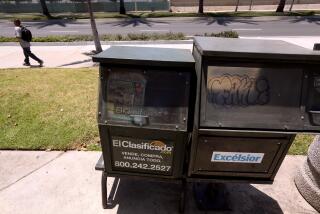REEL LIFE / FILM & VIDEO FILE : Ojai Group Seeks to Broaden Public Access TV : A media network would be created to distribute programs and teach communities the skills they need to produce their own programming.
It’s not often you hear people say, “Doggone it! There’s just not enough public access TV on.”
Yet an Ojai group is gearing up a campaign to create a media network for public access channels across the county.
“Our main purpose is to create a telecommunications center in Ojai,” said Carol McCartney, a documentary filmmaker on the board of the newly minted Ventura County Media Network. “We’ve been talking with the schools about ways we could bring multimedia into the classroom.”
Board member George Stuart said educators were “aflame” with the idea, and he defended Channel 8, the channel most cable providers in Ventura County use for public access.
“The 10 cities in Ventura are guaranteed access, but lots of them don’t make use of it because people in the community don’t have the skills,” he said. “Carol (McCartney) wants to teach the community those skills so they can develop programming for local access.”
Stuart said the Media Network would also help distribute public access programs from other communities in Ventura County.
“There’s a lot to look at here,” he said. “Local people don’t know what’s going on in their community.”
*
Of course programming isn’t all informative. The New Age spiritualists, political wackos and “Wayne’s World” wanna-bes that typically populate the band width are several wavelengths removed from the pluralistic forum public access was originally intended to create.
Jeff Cole, director of the UCLA Center for Communication Policy, recalls one Southern California television host who expressed disappointment that few people read books anymore, so he used to sit in front of the camera and read a book. But not out loud.
“To me, that’s most of public access,” Cole said. “Cheap, easy, sort of odd.” he said.
Public-access channels are governed by franchise agreements between the cable company and the city or town in which it operates. The agreements were an inducement cable operators offered to reluctant cities: Give us the franchise and we’ll provide public, educational or government (PEG) access, with no cost to the user.
Those who want to air a show must learn how to use the studio’s equipment. All they pay for is the tape; the cable operator provides cameras, editing equipment, lighting and instruction.
In the coming months, the Media Network will be putting together proposals for federal grants and private donations. Funds will be used for studio space, production equipment and a technician.
More to Read
The complete guide to home viewing
Get Screen Gab for everything about the TV shows and streaming movies everyone’s talking about.
You may occasionally receive promotional content from the Los Angeles Times.






